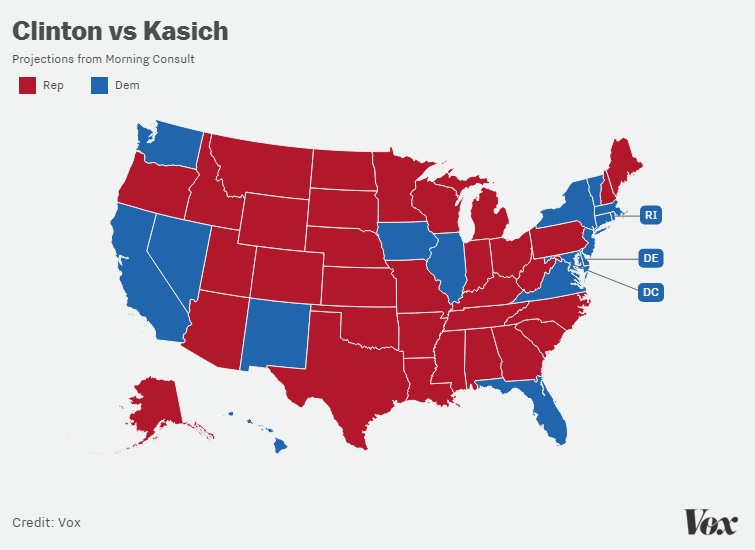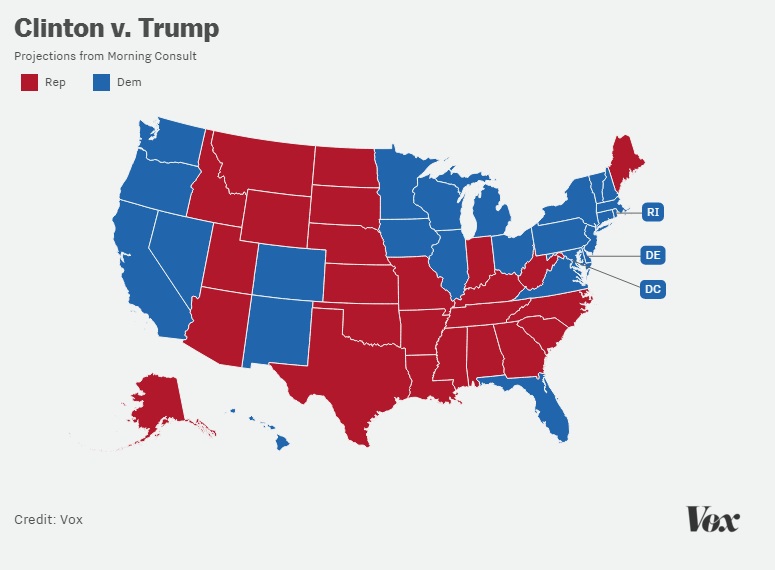By Jeff Stein
Ohio Gov. John Kasich may be running a distant third in the primary, but he’s the Republican presidential candidate best positioned to beat Hillary Clinton in a general election matchup.
That’s according to new projections released today by the nonpartisan technology and media company Morning Consult, which also found that Donald Trump and Ted Cruz would lose to Clinton in a general election.
In its polling over the past four months, Morning Consult has asked more than 44,000 registered voters across the country about which presidential candidate they’d prefer in a general election.
The researchers then took the results of those interviews and combined them with voter demographics and economic data to forecast an outcome in each state.
These models, as expected, show Clinton pretty easily winning Electoral College majorities over Trump and Cruz, the two Republican frontrunners.
But their projections also have Kasich — who’s very far back in the delegate count — clobbering Clinton and winning the most lopsided Republican presidential victory since George H.W. Bush in 1988.
This result is corroborated by national polls showing Kasich consistently leading Clinton. And it suggests that if Republicans actually want to win the White House, they should nominate the governor of Ohio.
Morning Consult’s projection suggests Kasich’s path to the White House would run through the Midwest
This early in the year, general election polling results in individual states should be interpreted with caution. There’s lots of time for things to change, and state polling tends to follow national vote swings.
Still, Morning Consult’s map of a Clinton-Kasich map is eye-popping, showing several states that have reliably voted for Democrats in recent years flipping back into the Republican column:

Interestingly enough, Morning Consult’s head-to-head matchups show Clinton actually ahead of Kasich in Florida (43-38), Nevada (42-39), and Virginia (41-40), which are traditionally thought of as among the closest toss-up states.
Yet she still loses overwhelmingly — she trails Kasich in a couple of traditional swing states (Colorado and Kasich’s home state of Ohio), and even narrowly trails him in bluer states like Pennsylvania, Michigan, Wisconsin, Minnesota, Maine, and Oregon.
“If the election were held today, John Kasich would receive 304 electoral votes to Hillary Clinton’s 234, largely due to strong performances in the Midwest and mid-Atlantic,” the company says.
Now, it’s worth remembering that Kasich has gotten little media attention so far and has scarcely been attacked by Democrats. If he actually became his party’s nominee, the race could well tighten. Still, it’s striking to see any projection put so many blue states in play.
Why Cruz and Trump are projected to lose big to Clinton
By contrast, both Ted Cruz and Donald Trump would lose to Clinton in a general election battle, according to the Morning Consult projections — though, interestingly, not in historic blowouts but instead by similar margins to Mitt Romney’s 2012 loss.
Both of the Republican frontrunners are highly unpopular with independents, with this key voting bloc opposing both of the Republican candidates by margins of more than 20 points.
Looking at the overall map, there’s not a huge gap between how badly Trump and Cruz would fare in a general election.
Clinton is projected to get in the ballpark of 330 Electoral College votes against each Republican (you need 270 to win), which is near President Obama’s 2012 tally of 332 electoral votes. Trump would get just 210 electoral votes, and Cruz would get 206.

Again, don’t read too much into the results of individual states here. It seems unlikely, for instance, that Trump could beat Clinton in Maine — after all, the state chose Barack Obama over Mitt Romney by a 15-point margin.
But these projections help confirm what pollsters and pundits have been saying for months: Trump and Cruz start off very badly positioned for a national campaign. The Morning Consult general election maps are a striking illustration of just how well — or badly — 2016 could go for the GOP.









